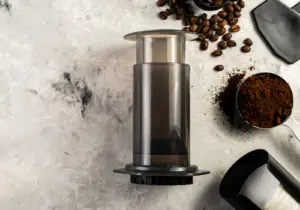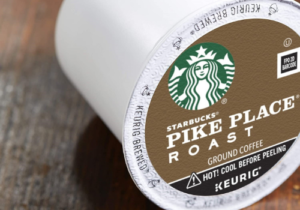Can You Put Milk In Nespresso Reservoir Instead Of Water
Disclosure: This post contains affiliate links and I may earn a small commission (at no extra cost to you) if you click through and make a purchase. Thanks in advance – I really appreciate it!
In the past few years, many of my friends who purchased a Nespresso coffee machine and wanted to experiment by filling milk in the reservoir instead of water, have asked me this question, and I have given them a very explicit answer for it.
Key Takeaways:
So, can you put milk in the Nespresso coffee machine reservoir instead of water?
Replacing water with milk in a Nespresso machine will adversely affect the taste and consistency of coffee. Milk contains protein that may coagulate if heated in the Nespresso machine which may promote the growth of bacteria. Milk residue and bacteria will render the machine unusable and unhygienic.
In this article, I will list down all the reasons why putting milk in a Nespresso coffee machine reservoir instead of water is not just risky for the proper functioning of your Nespresso machine but also poses some serious health risks for you too.
What Happens If You Put Milk In Nespresso Reservoir Instead Of Water
Technically, you can put milk in the reservoir, no one will stop you, it’s your machine, you bought it!
But, should you put milk in the Nespresso reservoir instead of water? – NEVER!
Although filling the water reservoir of your Nespresso machine with milk might seem like a convenient option in the present, it’s actually a very bad idea for the following reasons.
Let’s start with the least consequential.
Your coffee will taste bad.
Milk is not as effective as water is at extracting the flavor and aromas from the coffee capsules.
The coffee brewing process works best with water and that is what the Nespresso machines are built to do – To heat water and run it through the capsules to extract flavors from the grounds.
A Nespresso machine heats up water to around 181°F – 187°F (83-86°C), which ensures optimal extraction of the coffee aromas from Nespresso capsules without burning the coffee.
This simply means that water needs to be heated to a temperature of around 181°F – 187°F before its pressured through the capsule to deliver a freshly brewed delicious cup of coffee.
Milk, on the other hand, cannot be heated to such a high temperature as it begins to curdle as soon as the temperature reaches 180°F.
Therefore, milk cannot be heated to a temperature that is required for the optimum extraction of coffee flavors.
Also, the hydrophobic contents of coffee, like the caffeine and high notes can only be extracted thoroughly at a certain pace and temperature during the brewing process, which only water can provide.
Milk contains fat, which breaks down the hydrophobic content of coffee far quicker than water.
Coffee needs sufficient time to be brewed for proper extraction, but if you use milk instead of water, the oils and flavors will be extracted at a rapid pace, which would result in an incredibly bitter cup of coffee.
Milk will help the growth of bacteria in your machine.
Did you know that steamed milk in espresso drinks is only heated to around 155 degrees Fahrenheit?
It’s because of the same reason that we discussed before – Milk starts to curdle at 180 degrees Fahrenheit.
To make a perfect cup of coffee with a Nespresso machine, we need a temperature of at least 190 degrees Fahrenheit, which milk can’t handle.
If you fill the Nespresso reservoir with milk instead of water and try to brew a cup of coffee, the machine’s elements that are designed to heat water will scald the milk and it will start to curdle and coagulate.
Milk contains proteins and sugar that don’t exist in water. If you put milk into your Nespresso instead of water, the milk proteins remain stuck to the insides of your machine and the water reservoir. The milk remnants then start attracting bacteria.
Mold too may grow on everything the milk has touched during the coffee-making process.
It would also be very difficult to remove milk residue from your Nespresso machine.
The best solution would be to take apart the entire machine and sanitize each part individually. This would be a nightmare.
Milk will clog your Nespresso machine and render it useless.
As we already discussed, milk contains protein which begins to coagulate when heated above a specific temperature. This coagulated curdled milk is chunky and sticky, and it would stick to the insides of your machine, the parts that are designed to handle water.
Curdled milk is not only the culprit of disgusting coffee and a bacteria build-up, it can break your entire Nespresso machine.
With the growth of bacteria and mold, not will your next cup of coffee become deadly, your machine might also get clogged with curdled milk.
Once your Nespresso machine is clogged with rotten milk protein, the best option would be to discard it and buy a new one.
How To Add Milk To Coffee Using A Nespresso Machine
Now you must be wondering how can you add milk to your espresso to make those delicious cappuccinos and lattes? After all, that’s likely a top reason why you bought your Nespresso in the first place.
It’s quite simple!
Instead of risking bacteria and bad tasting coffee, make your coffee like you normally do and add milk on top of it afterward.
At least this way, you won’t have to worry about damaging your Nespresso machine or drinking unhygienic bacteria-infested coffee.
How To Froth Milk For Your Nespresso Coffee
If you don’t have a milk frother, you can also froth your milk by hand with a whisk or electric mixer. The steps just require a little bit of elbow grease.
- Fill ⅓ of a mug or bowl with milk and heat to 140ºF in a microwave. Make sure there’s enough room for your milk to double in size.
- With a whisk, use a vigorous back and forth motion to stir the milk until it doubles in size.
- Pour the appropriate quantity of milk slowly into your Nespresso coffee to make a delicious latte, cappuccino, or mocha.
How To Froth Milk Using A Nespresso Frother
You could use about any kitchen tool to froth milk, like a French press, a blender, a whisk, or even a lidded mason jar. The results may be bubbly, but it won’t have the right texture: that luscious and silky mouthfeel we love in milk-forward coffee drinks.
For that, you should use Aeroccino 4 Frother. This frother is easy to use, clean and froths non-dairy alternatives well.
The Aeroccino 4 Frother also has the option for denser and thicker foam, perfect for lattes and latte art. Simply pour milk into the frothing jug that has a removable whisk inside and attaches to an electric base.
With a push of a button, it can froth both hot and cold milk in a little over one minute and heat milk in about two.
On top of that, the Aeroccino 4 Frother is also dishwasher safe for ease of cleaning and it comes with hundreds of top reviews from satisfied customers.
You may even opt for Latteo Manual Milk Frother. This manual frother boasts design features that are similar to a French press.
Just add up to eight ounces of milk into the microwavable borosilicate glass jar, heat it up, and pump the mesh plunger up and down to create foam. It’s also clear, so you see the milk frothing without having to remove the lid.
Consider A Nespresso That Comes With A Built-in Frother
Another great option is to buy a Nespresso machine that comes with a milk frother built into it.
Take DeLonghi Nespresso Lattissima Pro Espresso Machine for example. This automatic coffee-and-espresso maker can brew all of your favorite drinks with the touch of a button.
Simply pop in a Nespresso capsule and choose from seven preprogrammed options: espresso, cappuccino, latte macchiato, ristretto, lungo, hot water, or warm milk froth.
The machine uses a 19-bar pressure pump system to pack maximum flavor into every espresso shot, and its integrated milk frother provides a café-worthy texture to lattes and cappuccinos.
Post-coffee cleanup is also easy, thanks to a sliding drip tray and an auto-clean function for the milk container.
You may also look at Nespresso Lattissima Touch Original Espresso Machine with Milk Frother. This mid-range model of Nespresso’s 5 Lattissima machines, the Touch has a large 44 oz water reservoir, 12 oz milk container, an integrated frother, and 6 preset recipes for easy one-touch specialty beverages.
Along with its 19-bar pressure pump and patented Automatic Cappuccino System, the De’Longhi Lattissima Touch features an innovative touch sensor control panel for easy operation.
This is a particularly wise purchase if you don’t have a lot of space in your kitchen as its sleek and compact design means it can be stored atop a counter or table without taking away room from other essential appliances.
Finally, the De’Longhi Lattissima Touch boasts a unique means of waste disposal, ejecting used Nespresso capsules into a collection tank to be emptied at your leisure.

Amit Gupta
Hi, my name is Amit Gupta, and I am the owner and contributor at Cafeish. My obsession with coffee started when I received my first French press as a gift almost ten years ago. Since then, my love of coffee – and the number of coffee gadgets I own – has grown considerably.
Most Popular
ABOUT US
We are a team of coffee affcianados with experience and expertise in making world renowned coffee. In fact, preparing the best coffee ever with a fluffy top reminds us of magic, with secrets of how to achieve each particular effect. Making coffee is not our only hobby, we always keep our ears open as to what’s happening around and what scientists and manufacturers produce for consumers. It’s not an easy task to do – it’s rather time consuming. Hence, Caféish website was launched.
LEGAL DISCLAIMER
Caféish is a participant in the Amazon Services LLC Associates Program, an affiliate advertising program designed to provide a means for sites to earn advertising fees by advertising and linking to Amazon.com. Caféish also participates in affiliate programs with Clickbank and other sites. Caféish is compensated for referring traffic and business to these companies.




